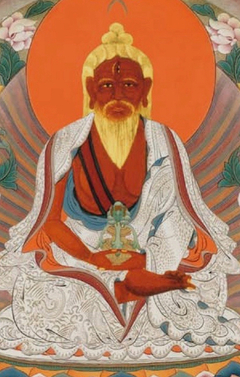Thangyal Tsedrup
English | Español | 中文 | བོད་ཡིག
༄༅། །བཀའ་གཏེར་དག་སྣང་ཟུང་དུ་འབྲེལ་བའི་ཚེ་སྒྲུབ་ཤིན་ཏུ་ཉེ་བརྒྱུད་ཀྱི་སྒྲུབ་ཐབས་དབང་ཆོག་དང་བཅས་པ་བཞུགས་སོ། །
The Sādhana and Empowerment for the Extremely Close Lineage of the Long-Life Practice that Unites the Oral, Treasure and Visionary Teachings
by Chöjé Lingpa
གྲུབ་པའི་དབང་ཕྱུག་དང་སློབ་དཔོན་ཆེན་པོ་གཉིས་སུ་མེད་པ་ལ་ཕྱག་འཚལ་ལོ། །
Homage to the Lord of Siddhas1 who is indivisible from the great master Padmasambhava!
དག་སྣང་དུ་གྲུབ་ཐོབ་ཆེན་པོས་མངོན་སུམ་དུ་བསྩལ་པའི་ཚེ་སྒྲུབ་ཁྱད་འཕགས་ཉམས་ལེན་ཟིན་བྲིས་ནི།
These notes on performing this extraordinary long-life practice were given to me in a vision directly by the Mahāsiddha2 himself.
རང་ཉིད་ཡི་དམ་རྟ་མགྲིན་སོགས་གང་རུང་དུ་གསལ།
Visualize yourself as a yidam deity, such as Hayagrīva, and imagine:
མདུན་གྱི་ནམ་མཁར་གནམ་ལྕགས་རྡོ་རྗེ་ནི། །
dün gyi namkhar namchak dorjé ni
In the sky before me appears a vajra of meteoric iron.
འགྱུར་མེད་རྡོ་རྗེ་རྩེ་ལྔ་མེ་འབར་གསལ། །
gyurmé dorjé tsé nga mebar sal
This unchanging, five-pronged vajra blazes with fire.
ལྟེ་དབུས་གྲུབ་པའི་དབང་ཕྱུག་ལྕགས་ཟམ་པ། །
té ü drubpé wangchuk chak zampa
In its centre resides the Lord of Siddhas, Thangtong Gyalpo, the Iron Bridge Builder.
ལོ་བརྒྱ་ལོན་ཚུལ་དབུ་སྐྲ་སྨ་ར་དང་། །
lo gya lön tsul utra mara dang
He appears as a hundred-year-old man, with white hair and a white beard.
ཨག་ཚོམ་དཀར་ལ་སྨུག་ནག་སྤྱན་གསུམ་འབར། །
aktsom kar la muknak chen sum bar
He is dark red in colour and his three eyes are aglow.
སྐུ་ལ་རས་གོས་དྲི་མ་མེད་པ་གསོལ། །
ku la ré gö drima mepa sol
He wears a white cotton robe.
རྡོ་རྗེའི་སྐྱིལ་ཀྲུང་མཉམ་གཞག་ཚེ་བུམ་འཛིན། །
dorjé kyiltrung nyam zhak tsebum dzin
He rests in equipoise in the crossed-legged vajra posture and holds a long-life vase.
དབུ་གཙུག་སངས་རྒྱས་སྣང་བ་མཐའ་ཡས་བཞུགས། །
u tsuk sangye nangwa tayé zhuk
Atop his head is Amitābha, Buddha of Limitless Light.
མགྲིན་པར་རྟ་མགྲིན་ཁྲོ་རྒྱལ་མེ་ཕུང་འབར། །
drinpar tamdrin trogyal mepung bar
At his throat, within a blazing mass of fire, is the Wrathful King, Hayagrīva.
ཐུགས་ཀར་པདྨ་འབྱུང་གནས་དཀར་དམར་མདངས། །
tukkar pema jungné kar mar dang
In his heart is Padmasambhava, his complexion white with a tinge of red.
དེ་རྣམས་གསལ་བསྒོམ་བདག་ཉིད་དུས་མིན་དུ། །
denam sal gom daknyi dümin du
By visualizing them clearly, all obstacles3
འཆི་སོགས་བར་ཆད་ཉེར་འཚེ་ཞི་བ་དང་། །
chi sok barché nyertsé zhiwa dang
And dangers, such as untimely death, are overcome,
ཚེ་རིང་འགྱུར་མེད་རྡོ་རྗེའི་སྐུ་འགྲུབ་ཕྱིར། །
tsering gyurmé dorjé ku drub chir
And long-life and the unchanging vajra-body are accomplished.
མདུན་གྱི་གྲུབ་ཐོབ་ཆེན་པོར་ཁ་སྙིང་སྤྲད། །
dün gyi drubtob chenpor kha nying tré
Upon meeting the Mahāsiddha face to face
མོས་གུས་བསྐྱེད་དེ་གསོལ་བ་འདི་ལྟར་བཏབ། །
mögü kyé dé solwa ditar tab
Devotion wells up, and so I offer this heartfelt prayer:
ཧྲཱིཿཧྲཱིཿཧྲཱིཿ སྣང་བ་མཐའ་ཡས་འགྲོ་ཀུན་རྗེས་སུ་སྐྱོང་། །
hrih hrih hrih, nangwa tayé dro kün jesu kyong
Hrīḥ, hrīḥ, hrīḥ! Buddha Amitābha, Limitless Light, you care for us, each and every one,
ཚེ་དཔག་མེད་མགོན་འགྲོ་ལ་འཆི་མེད་སྟེར། །
tsepakmé gön dro la chimé ter
Lord Amitāyus, Boundless Life, you grant us immortality,
རྟ་མགྲིན་དབང་རྒྱལ་འགྲོ་བའི་བར་ཆད་སེལ། །
tamdrin wanggyal drowé barché sel
All-powerful Hayagrīva, you eliminate every obstacle we face,
པདྨ་འབྱུང་གནས་སྙིགས་དུས་འགྲོ་བའི་སྐྱབས། །
pema jungné nyikdü drowé kyab
Padmasambhava, you are our refuge in this darkest of times,
ཐང་སྟོང་རྒྱལ་པོར་གསོལ་བཏབ་བསླུ་བ་མེད། །
tangtong gyalpor soltab luwamé
Thangtong Gyalpo, you never fail to answer our prayers.
གསོལ་བ་འདེབས་སོ་འགལ་རྐྱེན་བར་ཆད་སོལ། །
solwa deb so galkyen barché sol
Now, I pray to you all: dispel everything unfavourable, every obstacle,
བྱིན་གྱིས་རློབས་ཤིག་འཆི་མེད་དངོས་གྲུབ་སྩོལ། །
jingyi lob shik chimé ngödrub tsol
Fill me, transform me with your blessing—grant me the siddhi of immortal life!
ལན་གསུམ་གསོལ་བ་བཏབ་པས་གྲུབ་ཐོབ་དང་། །
len sum solwa tabpé drubtob dang
By reciting this prayer three times light radiates from the Mahāsiddha
གནས་གསུམ་ལྷ་ཡི་སྐུ་ལས་འོད་ཟེར་འཕྲོས། །
né sum lha yi ku lé özer trö
And from the deities residing in his three centres,
བདག་གི་བླ་ཚེ་ཡར་པ་ཐོར་པ་དང་། །
dak gi la tsé yarpa torpa dang
Causing my dissipated and scattered life force,
སྡེ་བརྒྱད་མི་མ་ཡིན་གྱི་བར་ཆད་དང་། །
dé gyé mi mayin gyi barché dang
The obstacles created by the eight classes of non-humans,
འབྱུང་བཞིའི་བཅུད་དང་སྐྱེ་འགྲོའི་ཚེ་བསོད་དང་། །
jung zhi chü dang kyendrö tsesö dang
The essence of the four elements, beings’ longevity and merit,
འཕགས་པའི་ཐུགས་རྗེ་ཐམས་ཅད་འཆི་མེད་ཀྱི། །
pakpé tukjé tamché chimé kyi
And all the compassion of the noble ones
བདུད་རྩི་འོད་ཟེར་སྦྲང་རྩི་ལྟ་བུར་བསྡུས། །
dütsi özer drangtsi tabur dü
To gather in honey-like light rays of immortal nectar,
བུམ་པར་ཐིམ་པས་མ་ཤོང་ཁ་ནས་ལུད། །
bumpar timpé ma shong kha né lü
Which melt into his long-life vase, causing it to overflow
བདག་གི་ཚངས་པའི་བུ་ག་ནས་མར་ཞུགས། །
dak gi tsangpé buga né mar zhuk
And enter my body through the brahma-aperture.
ལུས་ཀུན་གང་བས་འཆི་མེད་ཚེ་དབང་ཐོབ། །
lü kün gangwé chimé tsewang tob
It fills my whole body and grants the empowerment of immortality.
མ་ཡེངས་སྔགས་འདི་ཉིན་བཞིན་བརྒྱ་རྩ་བརྗོད།
Without distraction recite this mantra one hundred times every day:
ཨོཾ་ཨ་མཱ་ར་ཎི་ཛཱི་ཝནྟི་གུ་རུ་པདྨ་ཀྲོ་དྷ་པུཎྱེ་ཛྙཱ་ན་ཨཱ་ཡུར་སིདྡྷི་ཧྲཱིཿཧྲཱིཿཧྲཱིཿ
om amarani dziwenti guru pema krodha punyé jnana ayur siddhi hrih hrih hrih
oṃ amāraṇi jīvantaye guru-padma-krodha punye jñāna āyur siddhi hrīḥ hrīḥ hrīḥ
ཐ་མར་གྲུབ་ཐོབ་ཆེན་པོ་འོད་དུ་ཞུ། །
tamar drubtob chenpo ö du zhu
At the end the Mahāsiddha melts into light.
བདག་ལ་ཐིམ་པས་བདག་ཉིད་གྲུབ་ཆེན་སྐུ །
dak la timpé daknyi drubchen ku
He dissolves into me, and I assume the form
སྔ་མ་ལྟ་བུ་རྡོ་རྗེའི་གདན་ལ་འཁོད། །
ngama tabu dorjé den la khö
Of the Mahāsiddha seated in the vajra’s centre as before.
རྭ་རྩེ་ནས་འཕྲོས་མཚོན་ཆ་མེ་གུར་གྱིས། །
ratsé né trö tsöncha mé gur gyi
Weapons stream forth from the vajra’s prongs forming a blazing tent.
བར་གཅོད་སྲུང་བའི་འཁོར་ལོས་བསྐོར་བར་བསྒོམ། །
barchö sungwé khorlö korwar gom
I meditate on a spinning protection circle which guards against obstacles.
གསོལ་འདེབས་བརྒྱ་དང་རྩ་བརྒྱད་དང་། །
སྔགས་འདི་སྟོང་ཕྲག་རེ་རེ་ནི། །
ཉིན་རེ་བཞིན་དུ་བཟླས་པ་ན། །
ལོ་བརྒྱ་ཐུབ་ཅིང་སྟོན་བརྒྱ་མཐོང་། །
ཐེ་ཚོམ་མེད་དོ་རྦད་མིན་ནོ། །
If you recite the prayer one hundred and eight times
And the mantra one thousand times every day,
Have no doubt that
You will reach a hundred years
And see a hundred autumn moons!
འདི་ནི་གྲུབ་ཐོབ་ཆེན་པོས་མངོན་སུམ་དུ་བསྩལ་པ་ལྟར་ཟིན་བྲིས་སུ་བཀོད་དེ། བསམ་གཏན་དཔལ་འབྱོར་གྱིས་ཕུན་སུམ་ཚོགས་པའི་རིན་པོ་ཆེའི་མཎྜལ་གྱིས་མཉེས་པར་བྱས་པ་ལས། ཚེ་སྒྲུབ་མི་འདྲ་བ་དུ་མ་ཞིག་ཡོད་ཀྱང་། བྱིན་རླབས་འདི་ཀ་ཆེ་བར་བསམ་སྟེ་སྦྱིན་པའོ།། །།
I wrote these notes down as they were directly bestowed by the Mahāsiddha. After Samten Paljor made a lavish maṇḍala offering of precious substances, I thought that, although there are many long-life practices, this one possesses particularly potent blessings, and so gave it to him.
| Samye Translations 2020, (trans. Stefan Mang and Peter Woods). The prayer beginning with “nangwa tayé...” courtesy of Rigpa Translations.
Source:
bka' gter dag snang zung du 'brel ba'i tshe sgrub shin tu nye brgyud kyi sgrub thabs dbang chog dang bcas pa" in mkhyen brtse'i dbang po, blo gter dbang po. sgrub thabs kun btus. BDRC W23681. 14 vols. Kangra, H.P.: Indo-Tibetan Buddhist Literature Publisher, Dzongsar Inst. for Advanced Studies, null. Vol. 1: 475–478
Version: 1.2-20211229
